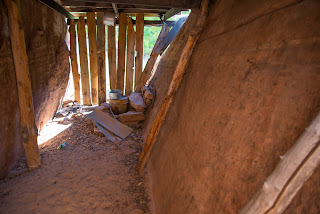With very sketchy directions, we bush-whacked cross-country to Diana's Throne Canyon hoping to explore its slotty sections. A number of spots required ropes we don't have and down-climbs we don't know how to do so we hiked to the rim in order to skirt obstacles and then made our way down into the canyon below them. In tackling the canyon this manner, we increased both the mileage and difficulty of the hike but found some really unique places we would have missed otherwise.
First Downclimb
Hidden Chamber
View in Slot
Trail to Canyon
Second Downclimb
Soup Town is a cute little place that serves delicious soup and sandwiches in Orderville, just a few miles from Diana's Throne on Route 89. It was on our way to Joe's Rock Shop so we had lunch there for the third time. At Joe's, we bought some cool rocks, one of our weaknesses, and asked about septarian nodules. He gave us directions to the site where he mines them and said we were welcome to look for some on our own.
Septarians formed between 50 to 70 million years ago. As a result of volcanic eruptions, dead sea life was chemically attracted to the sediment around them, forming mud balls. As the ocean receded, the balls dried and cracked. Due to their bentonite content they also shrank in size, creating the cracks inside. As decomposed shells seeped down into the cracks in the mud balls, calcite crystals formed. The outer thin walls of calcite then transformed into aragonite. The name Septarian comes from the Latin word "septem", meaning seven, because the mud balls had a tendency to crack in 7 points in every direction, thereby creating the distinctive pattern these nodules exhibit. Septarians are composed of calcite (the yellow centers) and aragonite (the brown lines) enclosed in an outer grey layer of limestone.
The operation is located in one of the few non-lovely places in Utah--grayish-tan soil and rocks interspersed with sparse, scrubby, gray vegetation. The nodules tumble down into a wash after the heavy equipment digs into the hillsides. There was no shade and the wash was very deep and we were tired from all the climbing up and down we'd done in morning. We settled for scouting the base of the tailings pile because anything we found in the wash would have to be carried out of the wash. Without much searching we found two interesting broken nodules and were satisfied with this limited success.
Septarian Nodules Mining Site










